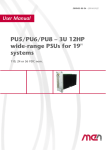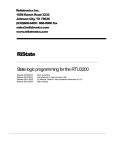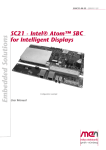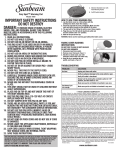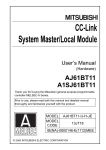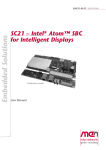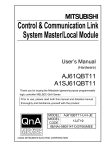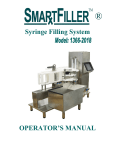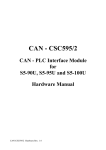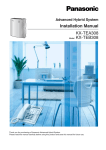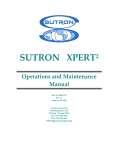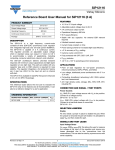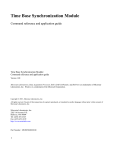Download MEN Mikro PU3 Manual
Transcript
Embedded Solutions
20AD78-00 E4 – 2011-09-12
PU2/PU3/PU4 –
3U 8HP Power Supply Units
for 19“ Systems
24, 36-48 or 72-110 VDC nom.
User Manual
®
PU2/PU3/PU4 – 3U 8HP PSUs for 19" systems, 24, 36-48 and 72-110 VDC nom.
PU2/PU3/PU4 – 3U 8HP PSUs for 19" systems,
24, 36-48 and 72-110 VDC nom.
The 3U 8HP power supply unit is a plug-in device for 19" systems (e.g. VMEbus,
CompactPCI®) and is especially designed for railway computer systems, being
fully compliant with EN 50155.
The PSU comes in three versions with nominal input voltages of 24 (PU2), 36 to 48
(PU3) and 72 to 110 VDC (PU4) with a wide input range of 0.7 to 1.25 times the
nominal voltage and a max. input voltage range of 0.6 to 1.4 times the nominal
voltage (according to EN 50155).
It is controlled by a microprocessor which supervises the output voltage and the
temperature, as well as three external inputs and three outputs.
Thanks to the on-board intelligence the PSU can also act as an SMBus slave and
communicate with the CPU board via the backplane. This allows the PSU to poweron the system at a programmed date or it allows the CPU to make status polls with
regard to error messages, time-out, on/off, for example.
The PSU provides a DC/DC converter to generate the isolated 5 V from the input
voltage. A buck regulator generates 3.3 V from the 5 V isolated side. The maximum
power at full load is 35 W.
The subassembly is conformally coated, and components are secured against
vibration. The PSU operates in -40 to +85°C environmental temperature. The
thermal stress is extremely low due to integrated heat sinks and diversion of
dissipated heat over the mounting surface.
MEN Mikro Elektronik GmbH
20AD78-00 E4 – 2011-09-12
2
Technical Data
Technical Data
Microcontroller
•
•
•
•
Output voltage and temperature supervision (readable via SMBus)
Overtemperature and overvoltage (output) shutdown
Communication with CPU
Watchdog functionality
SMBus
•
•
•
•
Signals on back connector
Voltage level 3.3 V
Controlled by CPU
Communication between the power supply unit and the CPU
Binary I/O
• 3 binary inputs
- Voltage level according to external power supply input voltage (max. 154
VDC)
- Electrically isolated
- External switch (key) with binary input
- Switch-on by key input or wake-on time
- Switch-off by key input or software
- Status of binary inputs readable via SMBus
- User-specific functionality (depending on firmware)
• 3 binary outputs
- Max. voltage 154 V
- Isolated by relays
- User-specific functionality (controllable via SMBus)
- Maximum switching power: 60 W
Miscellaneous
• DC/DC Converter
- Fuse-protected
• Two status LEDs on front panel
- Green LED indicates correct input voltage
- Yellow LED indicates correct output voltage
• Alternative power supply at the backplane for use as redundant PSU
• Short circuit protection
• Reverse polarity protection by internal protector
• Fixed switching frequency: 250 KHz
Input Characteristics
• Nominal voltage input: 24 VDC (PU2), 36-48 VDC (PU3), 72-110 VDC (PU4)
MEN Mikro Elektronik GmbH
20AD78-00 E4 – 2011-09-12
3
Technical Data
• Wide input range: 0.7 x nominal voltage < nominal voltage < 1.25 x nominal
voltage (according to EN 50155)
- 16.8..30 VDC (PU2)
- 25.2..60 VDC (PU3)
- 50.4..137.5 VDC (PU4)
• Max. input voltage range: 0.6 x nominal voltage < nominal voltage < 1.4 x nominal voltage with full functionality for 0.1 s, no damage for 1 s (according to EN
50155)
- 14.4..33.6 VDC (PU2)
- 21.6..67.2 VDC (PU3)
- 43.2..154 VDC (PU4)
• No load input power: 900 mW
Output Characteristics
•
•
•
•
•
Output power (max.): 35 W
5V tolerance: +5%/-3%
3.3V tolerance: ±3%
Overvoltage protection: +0.5 V/-0.2 V
Overtemperature shutdown: 50..90°C (adjustable by SMBus command)
Connection
• Input and output via DIN 41612 plug connector, type H15
Electrical Specifications
• Isolation (according to EN 50155)
- Input/output: 1,500 VDC/1,000 VRMS
- Input/shield: 1,500 VDC/1,000 VRMS
- Output/shield: 1,500 VDC/1,000 VRMS
- Ground/shield: 1,500 VDC/1,000 VRMS
• MTBF: 240,600 h @ 40°C (derived from MIL-HDBK-217F)
Mechanical Specifications
• Dimensions: 3U, 8HP, 128.4 mm height
• Integrated heat sink
• Weight: 665 g
Environmental Specifications
•
•
•
•
•
•
•
Temperature range (operation): -40..+85°C
Temperature range (storage): -40..+85°C
Airflow min. 10 m³/h
Shock: according to EN 60068-2-27
Continuous shock: according to EN 60068-2-29
Vibration: according to EN 60068-2-6
Protection
- Class of protection: Class II, EN 60950
- Degree of protection: IP20 (insert in rack), EN 60529
MEN Mikro Elektronik GmbH
20AD78-00 E4 – 2011-09-12
4
Technical Data
EMC
• Tested according to EN 55022 (radio disturbance), EN 61000-4-2 (ESD),
EN 61000-4-4 (burst) and EN 61000-4-5 (surge)
Software Support
• Driver software for Windows®; Linux, VxWorks (on request)
• For more information on supported operating system versions and drivers see
online data sheet.
MEN Mikro Elektronik GmbH
20AD78-00 E4 – 2011-09-12
5
Block Diagram
Block Diagram
5 V
Filter
DC/DC
Front Connector
FET On/Off Control
Regulator 3.3 VDC Rear Connector
3.3 V
BININ
Isolation
Microcontroller
SMBus
BINOUT
MEN Mikro Elektronik GmbH
20AD78-00 E4 – 2011-09-12
6
Product Safety
Product Safety
!
Electrostatic Discharge (ESD)
Computer boards and components contain electrostatic sensitive devices.
Electrostatic discharge (ESD) can damage components. To protect the board and
other components against damage from static electricity, you should follow some
precautions whenever you work on your computer.
• Power down and unplug your computer system when working on the inside.
• Hold components by the edges and try not to touch the IC chips, leads, or circuitry.
• Use a grounded wrist strap before handling computer components.
• Place components on a grounded antistatic pad or on the bag that came with the
component whenever the components are separated from the system.
• Store the board only in its original ESD-protected packaging. Retain the original
packaging in case you need to return the board to MEN for repair.
MEN Mikro Elektronik GmbH
20AD78-00 E4 – 2011-09-12
7
About this Document
About this Document
This user manual describes the hardware functions of the board, connection of
peripheral devices and integration into a system. It also provides additional
information for special applications and configurations of the board.
The manual does not include detailed information on individual components (data
sheets etc.). A list of literature is given in the appendix.
History
Issue
Comments
Date
E1
First issue
2006-11-15
E2
Update, error correction
2007-05-14
E3
Corrected and added more detailed information
regarding input voltage range
2010-06-23
Cosmetics
E4
Modified technical data to reflect extended voltage
range of PU3 (also suitable for 48 VDC nom.) and
PU4 (also suitable for 72 VDC nom.)
2011-09-12
Previous minimum power limit no longer applies
Clarified pin assignment regarding binary outputs,
marked one set of power outputs as alternate
Added connection example figure
Added figure to binary output sub-chapter
Added information regarding use in a redundant
system with multiple PUx models connected in parallel
Other minor changes, cosmetics
Conventions
!
italics
bold
monospace
This sign marks important notes or warnings concerning proper functionality of the
product described in this document. You should read them in any case.
Folder, file and function names are printed in italics.
Bold type is used for emphasis.
A monospaced font type is used for hexadecimal numbers, listings, C function
descriptions or wherever appropriate. Hexadecimal numbers are preceded by "0x".
comment
Comments embedded into coding examples are shown in green color.
hyperlink
Hyperlinks are printed in blue color.
MEN Mikro Elektronik GmbH
20AD78-00 E4 – 2011-09-12
8
About this Document
The globe will show you where hyperlinks lead directly to the Internet, so you can
look for the latest information online.
IRQ#
/IRQ
Signal names followed by "#" or preceded by a slash ("/") indicate that this signal is
either active low or that it becomes active at a falling edge.
in/out
Signal directions in signal mnemonics tables generally refer to the corresponding
board or component, "in" meaning "to the board or component", "out" meaning
"coming from it".
Vertical lines on the outer margin signal technical changes to the previous issue of
the document.
MEN Mikro Elektronik GmbH
20AD78-00 E4 – 2011-09-12
9
About this Document
Legal Information
MEN Mikro Elektronik GmbH ("MEN") reserves the right to make changes without further notice to any products herein.
MEN makes no warranty, representation or guarantee of any kind regarding the suitability of its products for any particular
purpose, nor does MEN assume any liability arising out of the application or use of any product or circuit, and specifically
disclaims any and all liability, including, without limitation, consequential or incidental damages. TO THE EXTENT
APPLICABLE, SPECIFICALLY EXCLUDED ARE ANY IMPLIED WARRANTIES ARISING BY OPERATION OF LAW,
CUSTOM OR USAGE, INCLUDING WITHOUT LIMITATION, THE IMPLIED WARRANTIES OF
MERCHANTABILITY AND FITNESS FOR A PARTICULAR PURPOSE OR USE. In no event shall MEN be liable for
more than the contract price for the products in question. If buyer does not notify MEN in writing within the foregoing
warranty period, MEN shall have no liability or obligation to buyer hereunder.
The publication is provided on the terms and understanding that:
1. MEN is not responsible for the results of any actions taken on the basis of information in the publication, nor for any error in
or omission from the publication; and
2. MEN is not engaged in rendering technical or other advice or services.
MEN expressly disclaims all and any liability and responsibility to any person, whether a reader of the publication or not, in
respect of anything, and of the consequences of anything, done or omitted to be done by any such person in reliance, whether
wholly or partially, on the whole or any part of the contents of the publication.
The correct function of MEN products in mission-critical and life-critical applications is limited to the environmental
specification given for each product in the technical user manual. The correct function of MEN products under extended
environmental conditions is limited to the individual requirement specification and subsequent validation documents for each
product for the applicable use case and has to be agreed upon in writing by MEN and the customer. Should the customer
purchase or use MEN products for any unintended or unauthorized application, the customer shall indemnify and hold MEN
and its officers, employees, subsidiaries, affiliates, and distributors harmless against all claims, costs, damages, and expenses,
and reasonable attorney fees arising out of, directly or indirectly, any claim or personal injury or death associated with such
unintended or unauthorized use, even if such claim alleges that MEN was negligent regarding the design or manufacture of the
part. In no case is MEN liable for the correct function of the technical installation where MEN products are a part of.
All products or services mentioned in this publication are identified by the trademarks, service marks, or product names as
designated by the companies who market those products. The trademarks and registered trademarks are held by the companies
producing them. Inquiries concerning such trademarks should be made directly to those companies.
Copyright © 2011 MEN Mikro Elektronik GmbH. All rights reserved.
Please recycle
Germany
MEN Mikro Elektronik GmbH
Neuwieder Straße 5-7
90411 Nuremberg
Phone +49-911-99 33 5-0
Fax +49-911-99 33 5-901
E-mail [email protected]
www.men.de
MEN Mikro Elektronik GmbH
20AD78-00 E4 – 2011-09-12
France
MEN Mikro Elektronik SA
18, rue René Cassin
ZA de la Châtelaine
74240 Gaillard
Phone +33 (0) 450-955-312
Fax +33 (0) 450-955-211
E-mail [email protected]
www.men-france.fr
USA
MEN Micro, Inc.
24 North Main Street
Ambler, PA 19002
Phone (215) 542-9575
Fax (215) 542-9577
E-mail [email protected]
www.menmicro.com
10
Contents
Contents
1 Getting Started . . . . . . . . . . . . . . . . . . . . . . . . . . . . . . . . . . . . . . . . . . . . . . . .
1.1 Map of the Board. . . . . . . . . . . . . . . . . . . . . . . . . . . . . . . . . . . . . . . . .
1.2 Integrating the Board into a System . . . . . . . . . . . . . . . . . . . . . . . . . .
1.3 Installing Driver Software . . . . . . . . . . . . . . . . . . . . . . . . . . . . . . . . . .
14
14
14
14
2 Connecting the PSU . . . . . . . . . . . . . . . . . . . . . . . . . . . . . . . . . . . . . . . . . . . . 15
2.1 Using the PSU in a Redundant Configuration. . . . . . . . . . . . . . . . . . . 17
3 Functional Description . . . . . . . . . . . . . . . . . . . . . . . . . . . . . . . . . . . . . . . . . .
3.1 Microcontroller . . . . . . . . . . . . . . . . . . . . . . . . . . . . . . . . . . . . . . . . . .
3.2 Power Up . . . . . . . . . . . . . . . . . . . . . . . . . . . . . . . . . . . . . . . . . . . . . . .
3.3 Power Down . . . . . . . . . . . . . . . . . . . . . . . . . . . . . . . . . . . . . . . . . . . .
3.4 Binary I/O . . . . . . . . . . . . . . . . . . . . . . . . . . . . . . . . . . . . . . . . . . . . . .
3.4.1
Binary Inputs. . . . . . . . . . . . . . . . . . . . . . . . . . . . . . . . . . . . .
3.4.2
Binary Outputs . . . . . . . . . . . . . . . . . . . . . . . . . . . . . . . . . . .
3.5 Status LEDs . . . . . . . . . . . . . . . . . . . . . . . . . . . . . . . . . . . . . . . . . . . . .
3.6 SMBus . . . . . . . . . . . . . . . . . . . . . . . . . . . . . . . . . . . . . . . . . . . . . . . . .
3.6.1
General . . . . . . . . . . . . . . . . . . . . . . . . . . . . . . . . . . . . . . . . .
3.6.2
SMBus Interface . . . . . . . . . . . . . . . . . . . . . . . . . . . . . . . . . .
3.6.3
Wake On Time. . . . . . . . . . . . . . . . . . . . . . . . . . . . . . . . . . . .
3.6.4
Watchdog. . . . . . . . . . . . . . . . . . . . . . . . . . . . . . . . . . . . . . . .
3.6.5
Status of Binary Inputs and Outputs . . . . . . . . . . . . . . . . . . .
3.6.6
Key Input. . . . . . . . . . . . . . . . . . . . . . . . . . . . . . . . . . . . . . . .
3.6.7
Shutdown. . . . . . . . . . . . . . . . . . . . . . . . . . . . . . . . . . . . . . . .
3.6.8
Voltage Supervision . . . . . . . . . . . . . . . . . . . . . . . . . . . . . . .
3.6.9
Temperature Supervision . . . . . . . . . . . . . . . . . . . . . . . . . . .
3.6.10 PSU ID and Firmware Revision Number . . . . . . . . . . . . . . .
3.7 DC/DC Converter . . . . . . . . . . . . . . . . . . . . . . . . . . . . . . . . . . . . . . . .
3.7.1
Fuse Protection . . . . . . . . . . . . . . . . . . . . . . . . . . . . . . . . . . .
18
18
19
19
20
20
20
21
21
21
21
22
22
24
25
26
30
31
32
32
33
4 Appendix . . . . . . . . . . . . . . . . . . . . . . . . . . . . . . . . . . . . . . . . . . . . . . . . . . . . . 34
4.1 Literature and Web Resources . . . . . . . . . . . . . . . . . . . . . . . . . . . . . . . 34
4.2 Finding out the Product’s Article Number, Revision
and Serial Number . . . . . . . . . . . . . . . . . . . . . . . . . . . . . . . . . . . . . . . . 34
MEN Mikro Elektronik GmbH
20AD78-00 E4 – 2011-09-12
11
Figures
Figure 1.
Figure 2.
Figure 3.
Figure 4.
Figure 5.
Figure 6.
Figure 7.
Figure 8.
MEN Mikro Elektronik GmbH
20AD78-00 E4 – 2011-09-12
Map of the board – front panel and top view . . . . . . . . . . . . . . . . . . . .
Connection example . . . . . . . . . . . . . . . . . . . . . . . . . . . . . . . . . . . . . . .
Microcontroller block diagram. . . . . . . . . . . . . . . . . . . . . . . . . . . . . . .
Power up by key input . . . . . . . . . . . . . . . . . . . . . . . . . . . . . . . . . . . . .
Binary output relay (one of three binary outputs shown). . . . . . . . . . .
Shutdown sequence . . . . . . . . . . . . . . . . . . . . . . . . . . . . . . . . . . . . . . .
Position of fuse for DC/DC converter protection. . . . . . . . . . . . . . . . .
Labels giving the product’s article number, revision
and serial number . . . . . . . . . . . . . . . . . . . . . . . . . . . . . . . . . . . . . . . . .
14
16
18
19
20
29
33
34
12
Tables
Table 1.
Table 2.
Table 3.
Table 4.
Table 5.
Table 6.
Table 7.
Table 8.
Table 9.
Table 10.
Table 11.
Table 12.
Table 13.
Table 14.
Table 15.
Table 16.
Table 17.
Table 18.
Table 19.
Table 20.
Table 21.
Table 22.
Table 23.
Table 24.
MEN Mikro Elektronik GmbH
20AD78-00 E4 – 2011-09-12
Pin assignment of H15 PSU connector (front) . . . . . . . . . . . . . . . . . . .
Pin assignment of H15 PSU connector (rear). . . . . . . . . . . . . . . . . . . .
Signal mnemonics of PSU interfaces . . . . . . . . . . . . . . . . . . . . . . . . . .
Status LEDs on the front panel. . . . . . . . . . . . . . . . . . . . . . . . . . . . . . .
SMBus commands for wake on time function . . . . . . . . . . . . . . . . . . .
SMBus commands AD78C_WOT_L/ AD78C_WOT_H . . . . . . . . . .
SMBus commands for watchdog function . . . . . . . . . . . . . . . . . . . . . .
SMBus command AD78C_WDOG_TOUT. . . . . . . . . . . . . . . . . . . . .
SMBus commands for binary inputs/outputs status . . . . . . . . . . . . . . .
SMBus commands for on acknowledge function. . . . . . . . . . . . . . . . .
SMBus on acknowledge timer modi . . . . . . . . . . . . . . . . . . . . . . . . . .
SMBus command for shutdown by software function . . . . . . . . . . . . .
SMBus commands for shutdown delay . . . . . . . . . . . . . . . . . . . . . . . .
SMBus command AD78C_STATUS. . . . . . . . . . . . . . . . . . . . . . . . . .
SMBus command AD78C_DOWN_DELAY . . . . . . . . . . . . . . . . . . .
SMBus command for off delay function . . . . . . . . . . . . . . . . . . . . . . .
SMBus command AD78C_OFF_DELAY . . . . . . . . . . . . . . . . . . . . . .
SMBus command for off acknowledge function . . . . . . . . . . . . . . . . .
SMBus command for voltage supervision function . . . . . . . . . . . . . . .
SMBus commands for temperature supervision. . . . . . . . . . . . . . . . . .
SMBus command AD78C_TEMP_HIGH . . . . . . . . . . . . . . . . . . . . . .
Temperature representation . . . . . . . . . . . . . . . . . . . . . . . . . . . . . . . . .
SMBus commands for PSU ID and firmware revision number . . . . . .
Maximum no load input power of DC/DC converter. . . . . . . . . . . . . .
15
15
16
21
22
22
23
23
24
25
26
26
27
27
27
28
28
28
30
31
31
31
32
32
13
Getting Started
1
Getting Started
This chapter gives an overview of the board and some hints for first installation in a
system.
1.1
Map of the Board
Figure 1. Map of the board – front panel and top view
H15 Connector Front
DC/DC Converter
H15 Connector Rear
Status LEDs
H15 Connector Front
Mounting screws
Fuse
Handle
Mounting screws
1.2
!
Integrating the Board into a System
This chapter gives important information on first installation of the PSU.
Power down the system before installing or removing the PSU.
Only operate the PSU in a suitable housing, i.e. in such a way that no parts of
the PSU except the front panel can be touched.
Make sure that enough airflow is provided.
Do not remove any covers or other mechanical parts.
The guiderails should be made of synthetic material and not touch any components.
1.3
Installing Driver Software
For a detailed description on how to install driver software please refer to the
respective documentation.
You can find any driver software available for download on MEN’s website.
MEN Mikro Elektronik GmbH
20AD78-00 E4 – 2011-09-12
14
Connecting the PSU
2
Connecting the PSU
The PSU can be connected via two H15 connectors at the front and at the rear side.
Connector types:
• 15-pin H15 receptacle according to IEC 60603-2
• Mating connector: 15-pin H15 plug according to IEC 60603-2
Table 1. Pin assignment of H15 PSU connector (front)
32
4
30
6
32
GND(I/O)
30
BININ2
28
BININ3
26
BINOUT3 RC2
24
BINOUT3 RC1
22
BINOUT2 RC2
20
BINOUT2 RC1
18
BINOUT1 RC2
16
-
14
BINOUT1 RC1
12
BININ1
10
Vin-
8
-
6
Vin+
4
SHIELD
Table 2. Pin assignment of H15 PSU connector (rear)
6
4
30
6
Vout5V+
4
GNDout
10
Vout5V+
8
Vout3.3V+
14
5V+ (3.3V Switch)
12
Vout3.3V+
18
SMBClk
16
System Reset
22
GND out
20
SMBDat
26
-
24
-
30
-
28
-
32
SHIELD
32
Note: Pin 32 is longer than the other pins.
MEN Mikro Elektronik GmbH
20AD78-00 E4 – 2011-09-12
15
Connecting the PSU
Table 3. Signal mnemonics of PSU interfaces
Signal
Function
SHIELD
Connection to cable shield
Vin+
Supply input voltage
Vin-
Supply input ground
BININ1
Key input
BINOUT1 RC1
User output1 relay contact 1
BINOUT1 RC2
User output1 relay contact 2
BINOUT2 RC1
User output2 relay contact 1
BINOUT2 RC2
User output2 relay contact 2
BINOUT3 RC1
User output3 relay contact 1
BINOUT3 RC2
User output3 relay contact 2
BININ3
Input
BININ2
Input
GND(I/O)
Key input ground
GNDout
Ground for system
Vout5V+
5V supply for system
Vout3.3V+
3.3V supply for system
5V+ (3.3V Switch)
12V for detection only (no power)
System Reset
Pushbutton reset
SMBClk
SMBus clock
SMBDat
SMBus data (handshake between CPU and PSU)
Figure 2. Connection example
External power source
CompactPCI system
MEN PSU (PU2/PU3/PU4)
4
CompactPCI backplane
Front connector
Rear connector
SHIELD
GNDout
8
12
4
BININ1
Vout 3.3V+
16
12
BINOUT2 RC1
20
24
BINOUT3 RC1
24
28
BININ3
32
GND(I/O)
SHIELD
+Vext
6
Vin+
Vout 5V+
‐Vext
10
Vin‐
10
14
BINOUT1 RC1
14
18
BINOUT1 RC2
18
22
BINOUT2 RC2
26
BINOUT3 RC2
26
30
BININ2
30
20AD78-00 E4 – 2011-09-12
3.3V
16
20
MEN Mikro Elektronik GmbH
GND
8
28
32
6
5V
16
Connecting the PSU
2.1
Using the PSU in a Redundant Configuration
The PSU can be used in parallel with other PSUs of the same type for increased
availability. There are a few limitations to such a configuration, though:
• It does not increase the maximum load.
• A failed PSU will not be able to sense that it has failed.
Both PSUs operate at the same address, so do not use SMBus commands!
MEN Mikro Elektronik GmbH
20AD78-00 E4 – 2011-09-12
17
Functional Description
3
Functional Description
The functions described in the following chapter depend on the firmware. This user
manual describes the functions realized in the current MEN standard firmware.
3.1
Microcontroller
The microcontroller is used as a control and supervision device of the DC/DC
converter and of the binary inputs and outputs of the PSU. Additionally it is used as
a watchdog for the CPU and the microcontroller itself. The microcontroller is
connected to the SMBus of the CompactPCI system. It controls the binary outputs
and is able to read the binary inputs. It is able to keep the power supply active, even
if the external on/off-signal goes inactive.
The microcontroller controls the CompactPCI reset signal to be able to reset the
complete CompactPCI bus. If a reset shall be performed the CompactPCI reset
signal is asserted for 250 ms.
Note: An operating system like Windows needs a controlled power down sequence.
The power supply of the CPU can be kept active via the SMBus even when
the external on/off signal of the PSU is inactive so that a controlled power
down of the operating system is possible. For further information see Chapter
3.6.7.4 Off Delay on page 28.
Figure 3. Microcontroller block diagram
Voltage Supervision
Temperature Supervision
A/D Converter
Binary Inputs
SMBus
SMB Slave
Binary Outputs
LED Out
MEN Mikro Elektronik GmbH
20AD78-00 E4 – 2011-09-12
In/Out Control
Control
Timer
Control Out
18
Functional Description
3.2
Power Up
The PSU can be switched on in the following two ways:
• Key input (ignition key) via isolated binary input (see Chapter 3.6.6 Key Input
on page 25).
Figure 4. Power up by key input
PU2/3/4
5V 3.3V
BININ1 Pin12
(Key)
Vout3.3V+ Pin12
GND(I/O) Pin32
Vout5V+ Pin30
Front I/O
Rear I/O
• Wake on time via the SMBus interface (see Chapter 3.6.3 Wake On Time on
page 22).
3.3
Power Down
The PSU can be switched off in the following two ways:
• Key input (ignition key) via isolated binary input (see Chapter 3.6.7.2 Shutdown
by Key Input on page 26).
• Shutdown by application software: the shutdown can be signaled via an SMBus
command from application to host (see Chapter 3.6.7.1 Shutdown by Software
on page 26).
MEN Mikro Elektronik GmbH
20AD78-00 E4 – 2011-09-12
19
Functional Description
3.4
Binary I/O
3.4.1
Binary Inputs
The PSU provides three binary inputs. The binary inputs are isolated from the
isolated system ground. The input voltage range is 0 V up to 154 V. The
nominal switching level is 9 V. The current is 5 mA. This value is independent of
the input voltage.
The isolated binary inputs are led to the microcontroller and can be used for user
specific functionality dependent on the firmware. The state of the binary inputs can
be read via the SMBus interface. See Chapter 3.6.5 Status of Binary Inputs and
Outputs on page 24.
3.4.2
Binary Outputs
The power supply unit provides three binary outputs. They are controlled by the
microcontroller and the state of the outputs is controllable via SMBus.
Figure 5. Binary output relay (one of three binary outputs shown)
PU5/6/8
BINOUT RC1
BINOUT RC2
Front I/O
The binary outputs are isolated by relays between each other and isolated system
ground. The default setting of "BINOUTx RC1" and "BINOUTx RC2" is open.
The maximum switching power of each binary output is 60 W.
The state of the binary outputs can be read via the SMBus interface. See Chapter
3.6.5 Status of Binary Inputs and Outputs on page 24.
MEN Mikro Elektronik GmbH
20AD78-00 E4 – 2011-09-12
20
Functional Description
3.5
Status LEDs
The PSU provides two status LEDs at the front panel. The green LED is on when
the input voltage is in the correct range, the yellow LED is on when the output
voltage is in the correct range. The yellow LED blinks when the PSU is switched to
error state off. See Chapter 3.6.4.1 Error Off State on page 23.
Table 4. Status LEDs on the front panel
LED
Function
Green LED
On: input voltage in correct range
Yellow LED
On: output voltage in correct range
Blinking: error state off
3.6
SMBus
3.6.1
General
The System Management Bus (SMBus) is a two-wire interface through which
various system component chips can communicate with each other and with the rest
of the system. It is based on the principles of operation of I²C.
SMBus provides a control bus for system and power management related tasks. A
system may use SMBus to pass messages to and from devices instead of tripping
individual control lines. Removing the individual control lines reduces pin count.
Accepting messages ensures future expandability.
With System Management Bus, a device can provide manufacturer information, tell
the system what its model/part number is, save its state for a suspend event, report
different types of errors, accept control parameters, and return its status.
3.6.2
SMBus Interface
The microcontroller firmware supports SMBus slave device functionality. The
SMBus address of the PSU is 0x12. The microcontroller behaves according to the
SMBus Specification Version 2.0 (see Chapter 4.1 Literature and Web Resources on
page 34), but it only supports the write-byte and the read-byte protocol without
PEC. The supported SMBus commands and their functions are explained in the
following chapters. The commands are listed by their unique name. Column "Data
Range" lists the valid range of the data byte for the specific command code. Column
"Type" specifies the data direction for the specific command. 'r' specifies that the
host can read the data using the SMBus read-byte protocol. 'w' means the host can
write data using the SMBus write-byte protocol.
MEN Mikro Elektronik GmbH
20AD78-00 E4 – 2011-09-12
21
Functional Description
3.6.3
Wake On Time
The PSU can be switched on/off by a programmable timer. The timer is included in
the microcontroller and is programmable by the CPU via SMBus commands (see
Table 5, SMBus commands for wake on time function, on page 22).
The behavior after power up by wake on time is identical to the behavior after power
up by key input. After the first wake on time event the wake on time feature is
disabled.
Note: For the timer functionality it is necessary that the DC/DC converter and the
microcontroller are active.
Table 5. SMBus commands for wake on time function
Name
Command
Code
Data
Range
Type
Description
AD78C_WOT_L
0x00
0x00..
0xFF
r/w
Wake on time low byte
AD78C_WOT_H
0x01
0x00..
0xFF
r/w
Wake on time high byte
The wake on time delay can be configured via SMBus in a 16 bit counter to provide
the range according to the following table:
Table 6. SMBus commands AD78C_WOT_L/ AD78C_WOT_H
Minimum
0 (OFF)
(default)
3.6.4
Maximum
65,535 min
Description
AD78C_WOT_L and AD78C_WOT_H build a 16 bit
value which represents the time in minutes
Watchdog
The microcontroller is also used as a watchdog for the CompactPCI system.
It is possible to enable/disable the watchdog by the SMBus command
AD78C_WDOG_STATE. After the AD78C_STATUS byte (see Table 13, SMBus
commands for shutdown delay, on page 27) signaled a shutdown the watchdog is
disabled by the firmware. The watchdog is triggered by cyclic SMBus commands
(AD78C_WDOG_TRIG) from the CPU. The time interval between trigger
commands is configurable via SMBus command AD78C_WDOG_TOUT (see Table
8, SMBus command AD78C_WDOG_TOUT, on page 23). The time interval is set
to its maximum value after PSU power up and the watchdog is disabled. In case of
missing trigger, the microcontroller firmware resets the complete system. The
number of missing SMBus trigger command exceptions is incremented and can be
read via the SMBus command AD78C_WDOG_ERR.
After five exceptions the microcontroller firmware switches off the power output
(Vout) and switches to error off state (see Chapter 3.6.4.1 Error Off State on page
23). After a watchdog reset the firmware waits for the SMBus on acknowledge
signal before it restarts the watchdog timer. Care must be taken if the SMBus on
acknowledge feature is not used and the system is not able to start within the
watchdog timeout time. In this case a deadlock situation occurs and after several
watchdog exceptions the system will fall into the error off state.
MEN Mikro Elektronik GmbH
20AD78-00 E4 – 2011-09-12
22
Functional Description
Table 7. SMBus commands for watchdog function
Command
Code
Name
Data
Range
Type
Description
AD78C_ONACK
0x02
0
w
On acknowledge
AD78C_ONACK_TOUT
0x03
0x00..
0x0B
r/w
On acknowledge
timeout
AD78C_ONACK_ERR
0x04
0x00..
0xFF
r
Number of missing
on acknowledges
AD78C_WDOG_STATE
0x05
0x00,
0x01
r/w
Watchdog state
AD78C_WDOG_TRIG
0x06
0
w
Watchdog trigger
signal
AD78C_WDOG_TOUT
0x07
0x01..
0xFF
r/w
Watchdog timeout
in 100ms steps
AD78C_WDOG_ERR
0x08
0x00..
0xFF
r
Number of missing
on watchdog
trigger signals
Table 8. SMBus command AD78C_WDOG_TOUT
Value
Watchdog Timeout
1
100 ms
2
200 ms
3
300 ms
...
255
3.6.4.1
25.5 s (default)
Error Off State
If five watchdog or SMBus on acknowledge exceptions have occurred the
microcontroller firmware switches to an error off state. This state is also reached if
an overtemperature or overvoltage condition has occurred. Upon entering this state
Vout is immediately deactivated. In this state it is not possible to switch on the
system in any way. To leave this state the power of the PSU must be disconnected
(power on reset of the PSU). This state is signaled via blinking of the yellow LED.
MEN Mikro Elektronik GmbH
20AD78-00 E4 – 2011-09-12
23
Functional Description
3.6.5
Status of Binary Inputs and Outputs
The status of the binary inputs and outputs is also signaled via SMBus commands.
See Table 9, SMBus commands for binary inputs/outputs status, on page 24.
Table 9. SMBus commands for binary inputs/outputs status
Name
Data
Range
Type
Description
AD78C_IN
0x0E
0x00..
0xFF
r
State of binary inputs
AD78C_IN_MASK
0x0F
0x00..
0x0F
r
Signal if binary input is
usable from application
AD78C_OUT
0x10
0x00..
0x0F
r/w
State of binary outputs
AD78C_OUT_MASK
0x11
0x00..
0x0F
r
Signal if binary output
is usable from
application
MEN Mikro Elektronik GmbH
20AD78-00 E4 – 2011-09-12
Command
Code
24
Functional Description
3.6.6
Key Input
3.6.6.1
Key Input On
The firmware switches on the output power (Vout) whenever the debounced state of
the binary input used as key switches from low to high state (on event). The
firmware debounces the key input in the following way: if the input is stable for
250ms the input state is interpreted.
3.6.6.2
SMBus On Acknowledge
The firmware provides an SMBus on acknowledge feature. This feature is enabled
by using mode 1 to 11 according to Table 11, SMBus on acknowledge timer modi,
on page 26. Default mode is 0 (feature disabled, no SMBus acknowledge required).
If enabled and the microcontroller does not receive a SMBus on acknowledge during the configurable SMBus on acknowledge delay, the microcontroller firmware
resets the complete system by activating the CompactPCI reset output. The number
of missing SMBus acknowledge exceptions are incremented and can be read via
SMBus command AD78C_ONACK_ERR.
After reset is released, the acknowledge timer is restarted and the microcontroller
firmware waits for SMBus acknowledge. After five exceptions the microcontroller
firmware disables the power output Vout (see Chapter 3.6.4.1 Error Off State on
page 23). After a power up of the PSU the on acknowledge configuration is reset.
Table 10. SMBus commands for on acknowledge function
Name
Data
Range
Type
Description
AD78C_ONACK
0x02
0
w
On acknowledge
AD78C_ONACK_TOUT
0x03
0x00..
0x0B
r/w
On acknowledge
timeout
AD78C_ONACK_ERR
0x04
0x00..
0xFF
r
Number of missing
on acknowledges
MEN Mikro Elektronik GmbH
20AD78-00 E4 – 2011-09-12
Command
Code
25
Functional Description
Table 11. SMBus on acknowledge timer modi
Mode
SMBus On Acknowledge
0
Feature disabled = no acknowledge required (default)
1
1s
2
2s
3
4s
4
8s
5
16 s
6
32 s
7
64 s
8
128 s
9
256 s
10
512 s
11
1024 s
3.6.7
Shutdown
3.6.7.1
Shutdown by Software
At any time it is possible to shut down the power supply by software via SMBus
command AD78C_SWOFF. A shutdown by software follows the shutdown
sequence.
Table 12. SMBus command for shutdown by software function
Name
AD78C_SWOFF
3.6.7.2
Command
Code
0x09
Data
Range
0
Type
w
Description
Signal a software power
off from application
Shutdown by Key Input
One of the binary inputs can be used as an on/off input. When this signal is
passive (open) during power up of the input voltage, the system is not supplied
with power. When this signals goes active, the microcontroller switches the power
supply to provide the system with power. Nevertheless the DC/DC converter and the
microcontroller are supplied when the input voltage is connected.
It is possible at any time to shut down the power supply by switching off the key
input. A shutdown by key input follows the shutdown sequence.
MEN Mikro Elektronik GmbH
20AD78-00 E4 – 2011-09-12
26
Functional Description
3.6.7.3
Shutdown Delay
During the shutdown sequence the microcontroller firmware provides a
programmable shutdown delay. The default state of the shutdown delay after power
up of the PSU is 0 (disabled). The shutdown delay is configurable via the SMBus
command AD78C_DOWN_DELAY, see Table 13, SMBus commands for shutdown
delay, on page 27 and Table 15, SMBus command AD78C_DOWN_DELAY, on
page 27. The shutdown delay timer is started after shutdown event. At any time
during the shutdown delay the shutdown sequence can be stopped by an on event
(key input on). The system is in running state then and the shutdown delay timer is
cleared. After timeout of the shutdown delay the microcontroller firmware signals
the shutdown event to the CPU by setting a bit in the status register, which can be
read using the SMBus command AD78C_STATUS (see Table 13, SMBus
commands for shutdown delay, on page 27 and Table 14, SMBus command
AD78C_STATUS, on page 27).
Table 13. SMBus commands for shutdown delay
Command
Code
Name
Data
Range
Type
Description
AD78C_DOWN_DELAY
0x0B
0x00..
0x07
r/w
Shutdown delay
AD78C_STATUS
0x0D
0x00,
0x01
r
Signal PSU status
to application
Table 14. SMBus command AD78C_STATUS
Bit
0
1..7
Value
Description
0
Shutdown event not signaled
1
Signal shutdown event
0
Reserved
Table 15. SMBus command AD78C_DOWN_DELAY
Value
0
0 min
1
1 min
2
2 min
3
4 min
4
8 min
5
16 min
6
32 min
7
64 min
MEN Mikro Elektronik GmbH
20AD78-00 E4 – 2011-09-12
Shutdown Delay
27
Functional Description
3.6.7.4
Off Delay
During the shutdown sequence the microcontroller firmware provides a
programmable off delay. As default this feature is not enabled (mode 0). In this case
there will be no off delay, the supply will be switched off immediately. When
enabled (mode 1…5) the firmware starts the off delay timer after signaling the
shutdown event to the CPU. After timeout the microcontroller firmware switches off
the supply voltage (Vout). Vout is kept disabled for at least 1 s, even if an immediate
on event occurs. This guarantees a proper power on reset of the supplied system.
The off delay can be programmed using the SMBus command
AD78C_OFF_DELAY, for details see Table 16, SMBus command for off delay
function, on page 28 and Table 17, SMBus command AD78C_OFF_DELAY, on
page 28.
Table 16. SMBus command for off delay function
Command
Code
Name
AD78C_OFF_DELAY
0x0C
Data
Range
Type
0x00..
0x05
r/w
Description
Off delay
Table 17. SMBus command AD78C_OFF_DELAY
Mode value
Off Delay
0
Feature off (no OFF delay: default)
1
1 min
2
2 min
3
4 min
4
8 min
5
16 min
3.6.7.5
Off Acknowledge
The microcontroller firmware enables acknowledging the shutdown. It is possible at
any time during off delay to shut down the power supply by the SMBus command
AD78C_OFFACK.
Table 18. SMBus command for off acknowledge function
Name
AD78C_OFFACK
MEN Mikro Elektronik GmbH
20AD78-00 E4 – 2011-09-12
Command
Code
0x0A
Data
Range
0
Type
w
Description
Signal off acknowledge
28
Functional Description
3.6.7.6
Shutdown Sequence
Any shutdown by software or key input is carried out according to the following
sequence:
Figure 6. Shutdown sequence
System ON
Wait on off
event
no
Watchdog
expiration 5
times
SW Shutdown
yes
yes
no
Key off
no
yes
SD Delay
Wait on SD
Delay timeout
or ON event
no
ON event (key
on / WOT)
no
yes
SD Delay
timeout
yes
OFF Delay
Signalize
Shutdown /
Wait on OFF
delay timeout
OR SMB OFF
Ack.
OFF delay
enabled
no
yes
no
OFF Delay
timeout
yes
no
SMB OFF
acknowledge
yes
System OFF
ERROR OFF
signalize with
blinking
POWER LED
no
PIC supply
OFF
yes
Restart possible
MEN Mikro Elektronik GmbH
20AD78-00 E4 – 2011-09-12
29
Functional Description
3.6.8
Voltage Supervision
Input and output voltage are supervised by the microcontroller. The status of the
input and output is shown by two LEDs at the front panel (see Chapter 3.5 Status
LEDs on page 21).
The microcontroller firmware supervises the 5 V output voltage of the DC/DC
converter. When the voltage is over 5.5 V, the microcontroller switches off the
output power and enters error off state. When the voltage is below 4.8 V, the
firmware of the microcontroller resets the system for the time of undervoltage. The
output voltage is measured using the microcontroller internal ADC function. The
ADC value which represents the output voltage can be read via the SMBus
command AD78C_VOLT (see Table 19, SMBus command for voltage supervision
function, on page 30. The voltage values are specified through their corresponding
ADC value. The read ADC values correspond to the voltage value according to the
following formula:
6 ADCValue
U = -------------------------------------- V
255
In order to provide stable voltage reference a 3 V precision shunt regulator is used.
The input voltage will be detected by two comparators.
Table 19. SMBus command for voltage supervision function
Name
AD78C_VOLT
MEN Mikro Elektronik GmbH
20AD78-00 E4 – 2011-09-12
Command
Code
0x14
Data
Range
0x00..
0xFF
Type
r
Description
5V supply voltage
30
Functional Description
3.6.9
Temperature Supervision
The microcontroller is able to determine the PSU temperature. The temperature can
be read via the SMBus command AD78C_TEMP and sent to the CPU.
The temperature supervision is carried out by the temperature sensor LM62. The
LM62 is a precision integrated-circuit temperature sensor that can sense a 0°C to
+90°C temperature range while operating from a single +3.0 V supply.
The microcontroller reads the output voltage of the LM62 with A/D input.
When the temperature is over the AD78C_TEMP_HIGH level the microcontroller
switches off the output power and changes to the error off state.
Table 20. SMBus commands for temperature supervision
Command
Code
Name
Data
Range
Type
Description
AD78C_TEMP
0x12
0x00..
0xFF
r
Current PSU
temperature
AD78C_TEMP_HIGH
0x13
0x00..
0xFF
r/w
Temperature
alarm limit (shut
down/ switching to
error off state)
The level AD78C_TEMP_HIGH can be configured via the SMBus between 50°C
and 90°C, see Table 21, SMBus command AD78C_TEMP_HIGH, on page 31 and
Table 22, Temperature representation, on page 31.
Table 21. SMBus command AD78C_TEMP_HIGH
Minimum
0x6B (50°C)
Maximum
0xA0 (90°C) (default)
Description
Temperature alarm level
The temperature limit can be read via the SMBus. The temperature value is
specified by the corresponding ADC value according to the following formula:
3
ADCvalue-----------------------------------– 0 . 48
255
t = ---------------------------------------------------------- C
0 . 0156
The following table shows how the ADC values correspond to the temperature
in °C.
Table 22. Temperature representation
ADC Value
0x28
0
0x2A
1
0x2B
2
...
...
0xA0
90
MEN Mikro Elektronik GmbH
20AD78-00 E4 – 2011-09-12
Temperature/°C
31
Functional Description
3.6.10
PSU ID and Firmware Revision Number
The ID of the PSU and the firmware revision number can also be read via SMBus
commands. See Table 23, SMBus commands for PSU ID and firmware revision
number, on page 32.
Table 23. SMBus commands for PSU ID and firmware revision number
Name
Command
Code
Data
Range
Type
Description
AD78C_ID
0xFE
0x78
r
ID of PSU
AD78C_REV
0xFF
0x00..
0xFF
r
Firmware revision of PSU
3.7
DC/DC Converter
The power supply unit provides a DC/DC converter to generate isolated 5 V (+5% ;
-3%) with 7 A from the input voltage. An additional buck regulator generates 3.3 V
(± 3%) from the 5 V isolated side. The maximum power with full load is 35 W.
Note: The DC/DC converter is on while the input voltage is connected. See Table
24, Maximum no load input power of DC/DC converter, on page 32 for maximum (no load) input power. The maximum output current of 3.3 V is 5 A.
For output voltage tolerance the minimum power must be 5 W.
Table 24. Maximum no load input power of DC/DC converter
Nominal Input Voltage
36-48VDC
72-110VDC
No load input power DC/DC
300 mW
500 mW
800 mW
Other parts
100 mW
100 mW
100 mW
Result power input
400 mW
600 mW
900 mW
MEN Mikro Elektronik GmbH
20AD78-00 E4 – 2011-09-12
24VDC
32
Functional Description
3.7.1
!
Fuse Protection
The DC/DC converter is protected by a fuse. This fuse is not intended to be
exchanged by the customer. Your warranty for the PSU will cease if you
exchange the fuses on your own. Please send your board to MEN for repair if a
fuse blows.
• Current rating:
- 5A for PU2
- 2.5A for PU3
- 1A for PU4
• Type: slow
• Size: 4.5 x 12.1
• MEN part number: 5675-0006 (1A), 5675-0010 (2.5A), 5675-0009 (5A)
The fuse is located on the top side of the PSU.
Figure 7. Position of fuse for DC/DC converter protection
DC/DC Converter
H15 Connector Rear
H15 Connector Front
Status LEDs
H15 Connector Front
Mounting screws
Fuse
Handle
Mounting screws
MEN Mikro Elektronik GmbH
20AD78-00 E4 – 2011-09-12
33
Appendix
4
Appendix
4.1
Literature and Web Resources
• PU2 data sheet with up-to-date information and documentation:
www.men.de/products/17PU02-.html
• PU3 data sheet with up-to-date information and documentation:
www.men.de/products/17PU03-.html
• PU4 data sheet with up-to-date information and documentation:
www.men.de/products/17PU04-.html
• System Management Bus (SMBus) Specification Version 2.0
August 3, 2000
SBS Implementers Forum
www.smbus.org
4.2
Finding out the Product’s Article Number, Revision and
Serial Number
MEN user documentation may describe several different models and/or design
revisions of the PSU. You can find information on the article number, the design
revision and the serial number on a label attached to the board.
• Article number: Gives the product’s family and model. This is also MEN’s
ordering number. To be complete it must have 9 characters.
• Revision number: Gives the design revision of the product.
• Serial number: Unique identification assigned during production.
If you need support, you should communicate these numbers to MEN.
Figure 8. Labels giving the product’s article number, revision and serial number
Complete article number
0712-0002
00.00.00
Revision number
Serial number
MEN Mikro Elektronik GmbH
20AD78-00 E4 – 2011-09-12
34


































